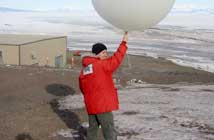
I recently got an email from one of our readers who had been reading the site from Antarctica. Since this is pretty darn cool, when Nick Vineyard offered to talk a little about his experiences and the punk scene in this isolated locale, I jumped at the chance to run it.
It's not an interview in the traditional sense, but a remarkable look at a community and how, despite being so far from home, they've managed to create their own little scene and even share it with each other.
Antarctica's not necessarily a bad place to be a punk. It's only fitting that a genre of music known for resourcefulness, adaptability and down-to-earth sensibility should be able to carve out a niche for itself in any possible environment.
Thanks to the magic of Al Gore's internet, fans of punk rock music from around the globe can converge in cyberspace to swap songs, set up gigs, discover new bands and trade information. This magnificent technology is valued immensely by isolated punk rockers located in remote parts of the globe, such as forward operating bases in Iraq, aircraft carriers in the middle of the ocean and even research stations in Antarctica, the latter of which I am currently writing from.
Antarctica, the last unconquered frontier on earth, is a seasonal home to a colorful, multi-cultured microcosm of humanity. Sure, there are scientists, researchers, doctors and engineers, but there are also plumbers, equipment operators, kitchen workers, supply clerks, janitors, firefighters and carpenters. It's not just a husky, weathered crew of grizzled men with white beards - there's plenty of dreadlocks and mohawks to go around. The atmosphere at McMurdo Station, the largest research station on the continent, resembles a small town; there are dormitories for the workers (and everyone's a worker) that resemble small studio apartments, a large dining room, humble athletic facilities, a library, a post office, a fire department, a coffeehouse and two taverns.
Within this sub-zero small-town environment is an even smaller but cohesive contingent of punk rock fans, ranging in age from early twenties to early fifties, who wear parkas over their Dropkick Murphys shirts, swap burned CDs of NOFX and Pere Ubu, and gather in the coffeehouse to watch documentaries such as "Dogtown and Z-Boys" and "We Jam Econo." The local volunteer radio station has a weekly punk rock showcase (DJed by yours truly) that churns out classic hits from the Clash and the Sex Pistols as well as newer material from bands like Rise Against and the Lawrence Arms, in addition to reading punk news headlines from this very fine website. One highlight of the summer season (which falls between October and February) is the outdoor concert known as Icestock, which occurs annually on January 1st, when the temperature gets up to a scorching 20 degrees Fahrenheit. The headlining band, made up of people from the community, cranks out a full set of Ramones cover songs while a handful of mitten-wearing moshers dance and pogo enthusiastically in front of the flat-trailer bed that serves as a makeshift stage.
Even though the mail can be delayed for weeks at a time and opportunities for live music are few and far between, Antarctica's not necessarily a bad place to be a punk. It's only fitting that a genre of music known for resourcefulness, adaptability and down-to-earth sensibility should be able to carve out a niche for itself in any possible environment.
By the way, here's a top 10 list of other titles I was considering for this article:
- Milo goes to Antarctica
- Seeing White
- Hey Antarctica
- Ruby So-Cold
- Blizzard Bop
- The freezing of the 5000
- Thirsty, miserable & frostbitten
- Walk together, freeze our asses off together
- Antarctica Burger (hold the hypothermia)
- F--k going outside, this is Antarctica



